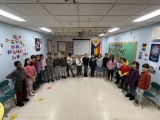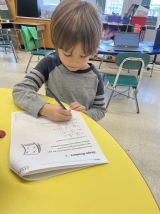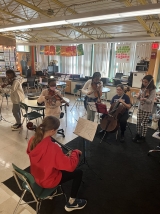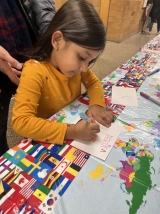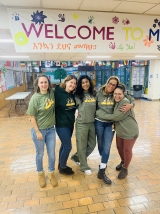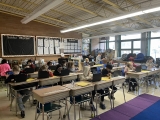-
Category 1
Selected in 2023
-
Grades: pre k - 5
School Setting: urban
Town Population: 117
Student Enrollment: 308
Student Demographics:
Black/African American: 25.5%
Teacher/Student Ratio: 1:25
White/Caucasian: 45%
Hispanic: 8.8%
Hawaiian/Pacific Islander: 0%
Asian: 9.5%
Native American: 0%
Other: 11.2%
% Reduced Lunch: 31.5%
% ELL Learners: 9.2%
Founded: 1891 -
PRINCIPAL:
Samantha Headley -
CONTACT:
40 Granite St
Cambridge, MA 02139
617-349-6571
sheadley@cpsd.us
Morse School
Cambridge, MA
We've focused on improving our use of student data to inform instruction and intervention.
- 1. Tell us about your school’s success.
-
Thanks to a range of intentional, collaborative, and systematic efforts in the two years following the pandemic, our students have demonstrated a high level of growth and achievement, relative to state and district peers representing a similar range of backgrounds and learning needs. Highlights from our school’s 2023 state accountability profile:
> Overall state accountability percentile increased from 63% in 2022 to 73% in 2023.
> Overall criterion-referenced target percentage was 87%. Students earned the maximum achievement and growth points (4 out of 4) in ELA and Math on the state accountability system.
> The criterion-referenced target percentage for our “high-needs” students was 92%.
> The achievement percentile for our Black/African American students was 95%, the result of intentional efforts to narrow the performance disparities among sub-groups at our school.
Through our responses below, we illustrate specific steps we took as a school community to achieve results.
- 2. Talk about the greatest contributing factor(s) that promoted positive change in your school.
- We focused on 3 primary areas to support our students' social & academic growth. First, our Equity & Social Emotional Learning teams led an intentional effort to foster a sense of community and belonging among students, families, and staff. We include the voices of all of our stakeholders, celebrating differences across our school community. We collaborate on events that build a sense of community and connection. We've focused on improving our use of student data to inform instruction and intervention. We consistently review student data, set growth goals and provide targeted support. Finally, to grow our students’ positive behavior and engagement with learning, we use restorative practices. We aim to address disruptive behaviors through problem-solving and collaboration with students, parents, and educators. Through our weekly community Live Stream, we spotlight student success and reinforce our core values: “Be inclusive, be kind, be responsible, and be an active learner.”
- 3. How has ESEA funding supported the school's success?
- In the 21-22 & 22-23 school years, Title I funding was invested into the Morse for 2.0 FTE Reading & Literacy Interventionists. Interventionists received professional learning & coaching around curriculum & instruction. Title I supported the free K-4 summer academic and support learning camp at the Morse with breakfast, lunch & transportation provided. The Office of Equity, Inclusion & Belonging was also created in 21-22, which directly benefited our families and community through more coordinated engagement activities:parent informational breakfasts, family literacy nights, family-friendly events, and a dedicated Title I Family Liaison to support Morse.We utilized Title IIA & Title IV funds to support a mentoring program for new teachers that included 1:1 support.Title III funds provided school-based instruction, and support for ELLs.Title III also supported ESOL courses for parents and caregivers of ELLs, as well as targeted summer programming for ELLs funded also by Title IA.
- 4. What professional development activities were used to improve teaching and learning?
- We've made 3 significant changes to our professional development. First, we created new systems & structures for monitoring student progress and using student data to inform Tier 1 instruction and targeted interventions. Three times a year, classroom teachers participated in full-day data meetings. They identified trends, considered whole-group strategies, and set growth targets for individual students. The result of this investment has been a much higher level of efficacy and precision in our classrooms. Second, we ensured each grade-level team had a weekly opportunity to engage in structured planning, in collaboration with our instructional coaches, interventionists, special educators, and ESL teachers. Teams looked at student work, planned lesson entry points for all students, observed each other via learning walks, and collaborated with special educators and interventionists to support students. Finally, we created an “Equity Team”, provided training in Restorative Justice circle facilitation, and coaching from an expert in the field of racial equity. Our Equity Team then led circle groups with staff to engage in deep and sustained thinking about specific ways that we can disrupt inequities and hold ourselves accountable for ensuring each child feels a sense of belonging and enjoys success no matter their level of readiness or starting point.
- 5. Talk about the cultural shift leading up to your school's success.
- Using the structures above as vehicles for adaptive change, complemented by sustained messaging of our core values through community-wide communications and individual teacher feedback, we saw three changes in our school culture: First, school staff collaborated to shift from an "I" to a "we" perspective. We placed students at the center of our work.Teachers considered the broad range of needs represented within their classrooms and learning spaces, rather than “pitching” their instruction towards the middle.Second, we shifted from a focus on “teaching” to a focus on “learning”.Rather than measuring success based on how much content is covered, we are more attuned to the impact on student learning.Finally, our staff became more purposeful about creating welcoming spaces for all learners.Every student must see themselves represented in the spaces they inhabit, while also having intentional opportunities to learn about and celebrate the differences represented among their classmates.
- 6. How has community involvement strengthened your success?
- The Morse School is strong because our community is strong. Staff and families collaborate regularly to support students academic and social emotional well-being. We hold 20 minute listening conferences in the fall to gather street level data about each student from their families. Each classroom holds multiple "celebrations of learning" to lift up student work for families and teacher send home weekly curriculum and learning updates to keep families in the loop. In addition, each classroom has a room parent that helps to disseminate information. Our parent organization, Friends of the Morse School support and sponsor many events that strengthen our community bonds such as movie nights, the Morse Marathon, and International Night.
Stats
-
Category 1
Selected in 2023
-
Grades: pre k - 5
School Setting: urban
Town Population: 117
Student Enrollment: 308
Student Demographics:
Black/African American: 25.5%
Teacher/Student Ratio: 1:25
White/Caucasian: 45%
Hispanic: 8.8%
Hawaiian/Pacific Islander: 0%
Asian: 9.5%
Native American: 0%
Other: 11.2%
% Reduced Lunch: 31.5%
% ELL Learners: 9.2%
Founded: 1891 -
PRINCIPAL:
Samantha Headley -
CONTACT:
40 Granite St
Cambridge, MA 02139
617-349-6571
sheadley@cpsd.us



